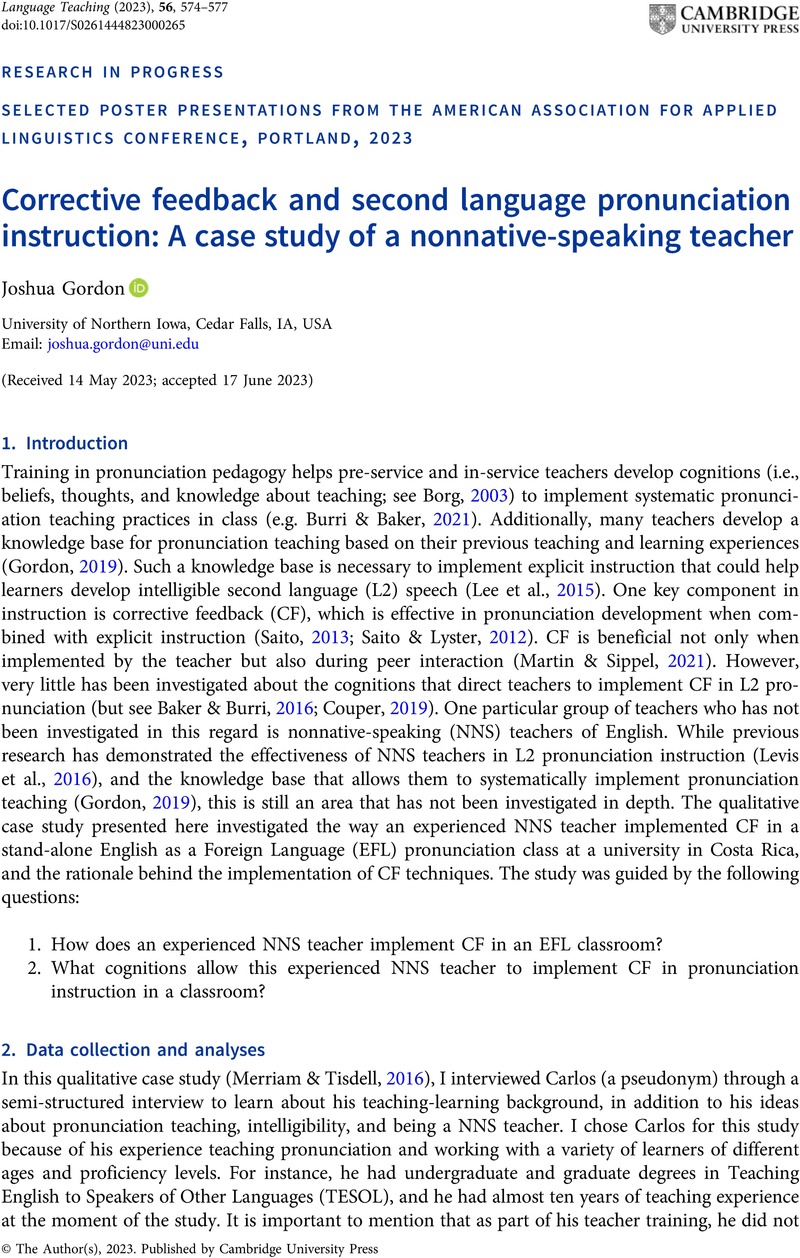No CrossRef data available.
Article contents
Corrective feedback and second language pronunciation instruction: A case study of a nonnative-speaking teacher
Published online by Cambridge University Press: 27 July 2023
Abstract
An abstract is not available for this content so a preview has been provided. Please use the Get access link above for information on how to access this content.

- Type
- Research in Progress
- Information
- Copyright
- Copyright © The Author(s), 2023. Published by Cambridge University Press
References
Baker, A., & Burri, M. (2016). Feedback on second language pronunciation: A case study of EAP teachers’ beliefs and practices. Australian Journal of Teacher Education, 41(6), 1–19. doi:10.14221/ajte.2016v41n6.1CrossRefGoogle Scholar
Borg, S. (2003). Teacher cognition in language teaching: A review of research on what language teachers think, know, believe, and do. Language Teaching, 36(2), 81–109. doi:10.1017/S0261444803001903CrossRefGoogle Scholar
Burri, M., & Baker, A. (2021). “I feel… slightly out of touch”: A longitudinal study of teachers learning to teach English pronunciation over a six-year period. Applied Linguistics, 42(4), 791–809. doi:10.1093/applin/amab009CrossRefGoogle Scholar
Couper, G. (2019). Teachers’ cognitions of corrective feedback on pronunciation: Their beliefs, perceptions and practices. System, 84, 41–52. doi:10.1016/j.system.2019.04.003CrossRefGoogle Scholar
Couper, G. (2022). Effective feedback for pronunciation teaching. In Levis, J. M., Derwing, T. M., & Sonsaat-Hegelheimer, S. (Eds.), Second language pronunciation: Bridging the gap between research and practice (pp. 174–193). Wiley.Google Scholar
Gordon, J. (2019). The knowledge base of L2 pronunciation teaching: The case of a nonnative-speaking teacher. TESL Canada Journal, 36(2), 91–117. doi:10.18806/tesl.v36i2.1315CrossRefGoogle Scholar
Johnston, B., & Goettsch, K. (2000). In search of the knowledge base of language teaching: Explanations by experienced teachers. Canadian Modern Language Review, 56(3), 437–468. doi:10.3138/cmlr.56.3.437CrossRefGoogle Scholar
Lee, J., Jang, J., & Plonsky, L. (2015). The effectiveness of second language pronunciation instruction: A meta-analysis. Applied Linguistics, 36(3), 345–366. doi:10.1093/applin/amu040CrossRefGoogle Scholar
Levis, J. M., Sonsaat, S., Link, S., & Barriuso, T. (2016). Native and nonnative teachers of L2 pronunciation: Effects on learner performance. TESOL Quarterly, 50(4), 894–931. doi:10.1002/tesq.272CrossRefGoogle Scholar
Lyster, R., & Ranta, L. (1997). Corrective feedback and learner uptake. Studies in Second Language Acquisition, 19(1), 37–66. doi:10.1017/S0272263197001034CrossRefGoogle Scholar
Martin, I. A., & Sippel, L. (2021). Is giving better than receiving? The effects of peer and teacher feedback on L2 pronunciation skills. Journal of Second Language Pronunciation, 7(1), 62–88. doi:10.1075/jslp.20001.marCrossRefGoogle Scholar
Merriam, S. B., & Tisdell, E. J. (2016). Qualitative research: A guide to design and implementation (4th ed.). Jossey-Bass.Google Scholar
Saito, K. (2013). The acquisitional value of recasts in instructed second language speech learning: Teaching the perception and production of English /ɹ/ to adult Japanese learners. Language Learning, 63(3), 499–529. doi:10.1111/lang.12015CrossRefGoogle Scholar
Saito, K., & Lyster, R. (2012). Effects of form-focused instruction and corrective feedback on L2 pronunciation development of /ɹ/ by Japanese learners of English. Language Learning, 62(2), 595–633. doi:10.1111/j.1467-9922.2011.00639.xCrossRefGoogle Scholar
Shulman, L. S. (1987). Knowledge and teaching: Foundations of the new reform. Harvard Educational Review, 57(1), 1–22. doi:10.17763/haer.57.1.j463w79r56455411CrossRefGoogle Scholar



